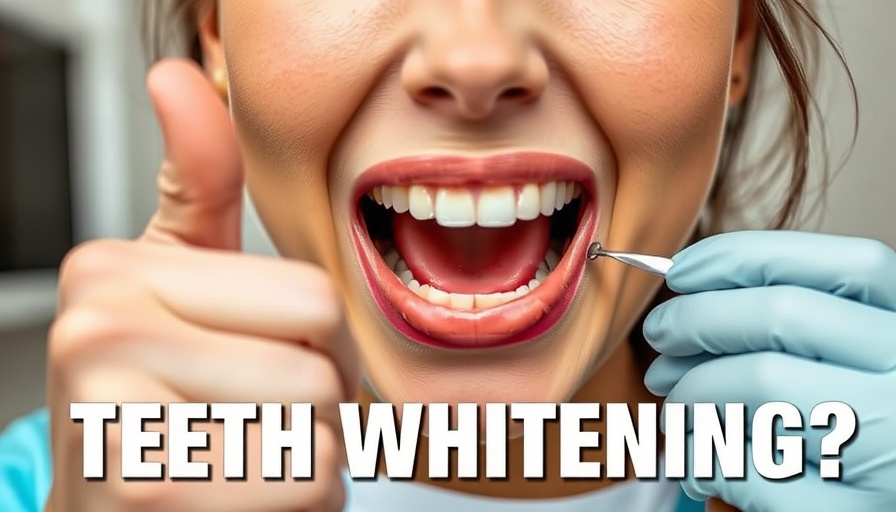
The Truth About Dental Polishing and Teeth Whitening
Have you ever left the dentist's office feeling that all-too-familiar sensation of cleanliness, but wondered if the polishing process also made your teeth whiter? You’re not alone! Many patients hold misconceptions about dental polishing versus dental whitening, believing that the polishing process itself has whitening capabilities. In this article, we’re diving deep into the differences between polishing and whitening, helping you understand what really happens during your dental visits.
In 'Does Polishing at the Dentist Actually Whiten Your Teeth?', the discussion dives into the differences between dental polishing and teeth whitening, exploring key insights that sparked deeper analysis on our end.
Understanding the Polishing Process
Dental polishing is a routine procedure that takes place during a professional teeth cleaning appointment. Your dental hygienist typically uses a gritty toothpaste-like substance and either a spinning rubber cup or an air polisher to buff and polish your teeth. The primary goal is to remove surface stains caused by coffee, tea, wine, or tobacco products. While this process can enhance the cosmetic appearance of your teeth, it importantly does not change the intrinsic color of your enamel. Instead, it merely eliminates superficial stains, leaving your teeth looking brighter but not actually whiter.
Health Benefits Beyond Aesthetic Improvements
Not only does polishing enhance appearance, but it also plays a vital role in oral health. By smoothing the surface of your teeth, it inhibits plaque from adhering to your enamel, which ultimately protects against cavities and gum diseases. With less plaque, you may find it easier to maintain oral hygiene at home. Coupled with good brushing habits and regular dental visits, polishing is an effective step toward a healthier smile.
Whitening: The Deeper Dive into Tooth Color
When it comes to achieving a genuinely whiter smile, dental polishing falls short; for those results, you’ll need to consider actual teeth whitening treatments. These treatments use peroxide-based agents—either hydrogen peroxide or carbamide peroxide—to penetrate the enamel and break down discoloration molecules at deeper levels. In contrast to polishing, whitening procedures provide long-lasting changes to your teeth's overall color by working from within.
Four Options for Achieving White Teeth
After professional polishing, if you're serious about whitening your teeth, several effective methods can deliver noticeable results:
- Whitening Strips: An affordable and user-friendly option, these strips typically need to be worn daily for a few weeks. However, they may be less effective for those with sensitive gums.
- Semi-Custom Trays: Offering a closer fit than strips, these trays can provide better results while remaining budget-friendly. Most users find them easier to manage over time.
- Custom Trays: Created by your dentist, these trays fit precisely to your teeth. Though they carry a higher initial cost, they offer longevity and comfort for ongoing use.
- In-Office Whitening: This method yields the quickest results, brightening your smile in about an hour. However, for those with sensitive teeth, this approach might lead to discomfort.
Dental Hygiene: A Habit Worth Cultivating
Ultimately, while polishing offers surface-level benefits, genuine whitening requires deeper treatments. Maintaining a consistent at-home care routine is crucial in maximizing your results—taking just a few moments daily to brush and floss can lead to significant improvements over time. Consider revisiting your oral care routine to ensure you're maximizing the health and appearance of your teeth.
Conclusion: Your Path to a Gleaming Smile
In conclusion, while polishing at the dentist does not inherently whiten your teeth, it significantly contributes to maintaining oral health and removing unsightly surface stains. If you seek that pearly white smile, follow up your cleanings with one of the proven whitening methods discussed. Remember, a bright smile can be yours, but it takes a little effort and the right approach!
For even further guidance on constructing a personalized oral care routine, be sure to access our free oral care guide in the link below. Knowing how to maintain your dental health at home is just as important as your regular visits to the dentist!
 Add Row
Add Row  Add
Add 




Write A Comment